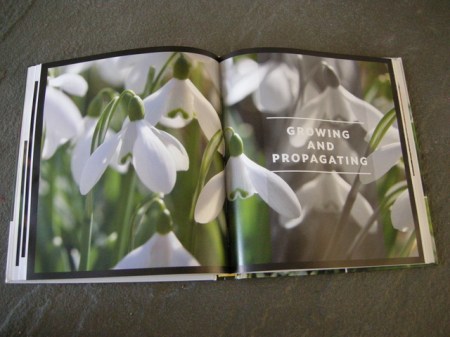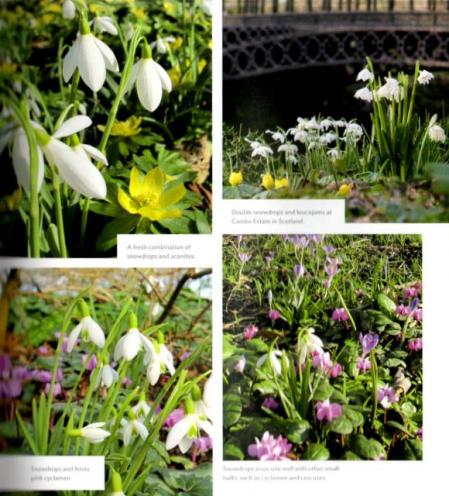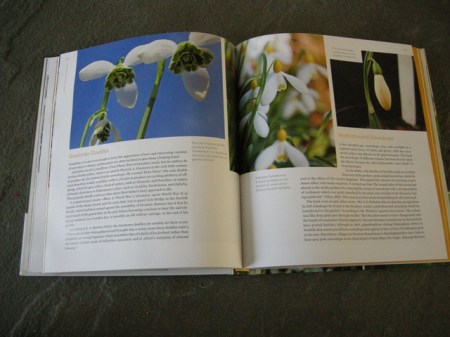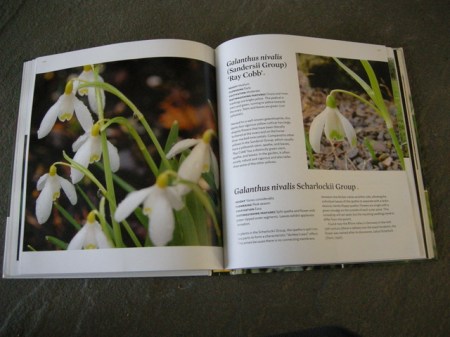Our current snowdrop catalogue is on line here.
 The cover of the exciting new snowdrop book recently published in The Plant Lover’s Guide Series by Kew Gardens in London.
The cover of the exciting new snowdrop book recently published in The Plant Lover’s Guide Series by Kew Gardens in London.
I don’t think I have ever done a book review on this blog, but I want to share my excitement about the new snowdrop book published by Timber Press in association with the Royal Botanic Gardens, Kew, in London. It is called The Plant Lover’s Guide to Snowdrops and was written by Naomi Slade, a prize-winning British journalist. I highly recommend it as an invaluable resource for gardeners at all levels in their love of snowdrops, from novice to expert.
Nursery News: Carolyn’s Shade Gardens is a retail nursery located in Bryn Mawr, PA, specializing in showy, colorful, and unusual plants for shade. The only plants that we ship are snowdrops to the US only. For catalogues and announcements of local events, please send your full name, mailing address, and cell number to carolyn@carolynsshadegardens.com and indicate whether you are mail order only. Click here to get to the home page of our website for catalogues and information about our nursery and to subscribe to our blog.
.
 Common snowdrops, G. nivalis, at Welford Park in Berkshire, England—just one of the locations identified in the book as a place to see snowdrops (photo by Naomi Slade appears on page 16) .
Common snowdrops, G. nivalis, at Welford Park in Berkshire, England—just one of the locations identified in the book as a place to see snowdrops (photo by Naomi Slade appears on page 16) .
The best part of the book for me is the photographs, both those accompanying the individually profiled snowdrops, which are both enticing and accurate, and also the many pictures of snowdrops in gardens mostly in the US and UK, which are quite beautiful. Whether you are a thoroughly obsessed galanthophile or just thinking of branching out with snowdrops for the first time, you will love reading this book, not once but over and over.
.
 The title page for the chapter on Growing and Propagating snowdrops.
The title page for the chapter on Growing and Propagating snowdrops.
The book is divided into five main chapters followed by further information on where to see snowdrops and where to buy them. Slade begins with an explanation of “Why I Love Snowdrops” that sets the tone for the whole book, which is approachable, informative, and refreshing. Although the author points out that a lack of detailed knowledge is not a barrier to appreciating this universally loved plant, her enthusiasm makes you want to acquire or revisit that knowledge.
.
 Photos illustrating the discussion of good companion plants for snowdrops.
Photos illustrating the discussion of good companion plants for snowdrops.
The next section of the book considers “Designing with the Milk Flower”. Slade discusses garden design and placement, easy snowdrops for beginners, naturalizing, rock gardens, and container planting. There are many inspired ideas for companion plantings covering other bulbs, perennials, trees, and shrubs.
.
 Creative uses of snowdrops in containers
Creative uses of snowdrops in containers
In “Understanding Snowdrops”, the book explains in a user-friendly way snowdrop morphology or structure, concepts that are important to understanding the differences between snowdrops and deciphering written descriptions of them. Slade covers snowdrop species and their origins, conservation and trade, and even snowdrop theft.
.
 Although originally mostly single-flowered and green and white, Slade explains that the Greatorex doubles led to many more double forms and that yellow and even orange snowdrops can be found.
Although originally mostly single-flowered and green and white, Slade explains that the Greatorex doubles led to many more double forms and that yellow and even orange snowdrops can be found.
.
 Profiles of ‘Grumpy’ and G. elwesii var. monostictus
Profiles of ‘Grumpy’ and G. elwesii var. monostictus
The “Spotter’s Guide” section highlights 60 snowdrops chosen with great care to represent the range available and includes many of the most-loved and best-performing cultivars. The photographs are excellent and the individual descriptions are fresh and informative.
.  Each snowdrop profiled gets plenty of space for photos and descriptions.
Each snowdrop profiled gets plenty of space for photos and descriptions.
The final main section is on “Growing and Propagating” and covers planting, dividing, fertilizing, propagating, and pests and diseases. This is followed by a very comprehensive guide to where to see snowdrops worldwide, including the US, and where to buy them, including Carolyn’s Shade Gardens.
.
 Cambo Estate in Scotland is a great place to see snowdrops, while the Scottish Rock Garden Club forum on galanthus, click here, is a great place to learn about snowdrops.
Cambo Estate in Scotland is a great place to see snowdrops, while the Scottish Rock Garden Club forum on galanthus, click here, is a great place to learn about snowdrops.
One of Naomi Slade’s missions in writing this book was to appeal to an American audience, and she has succeeded. While the UK is definitely the eye of the current snowdrop tornado, Slade ferrets out a lot of information useful to US readers. Of the eight snowdrop professionals whose interviews she spreads through out the book, three of them are American, including me on page 76. The book identifies and also anticipates the snowdrop collecting frenzy that is coming to America. I can’t wait.
.
 Another photo of Welford Park by Naomi Slade.
Another photo of Welford Park by Naomi Slade.
If you would like to order a copy of this book, Carolyn’s Shade Gardens has it available for $24.95 plus $5.95 for priority shipping. Send an email to carolynsshadegardens@verizon.net.
Carolyn
Note: Every word that appears in orange on my blog is a link that you can click for more information. If you want to return to my blog’s homepage to access the sidebar information (catalogues, previous articles, etc.) or to subscribe to my blog, just click here.































